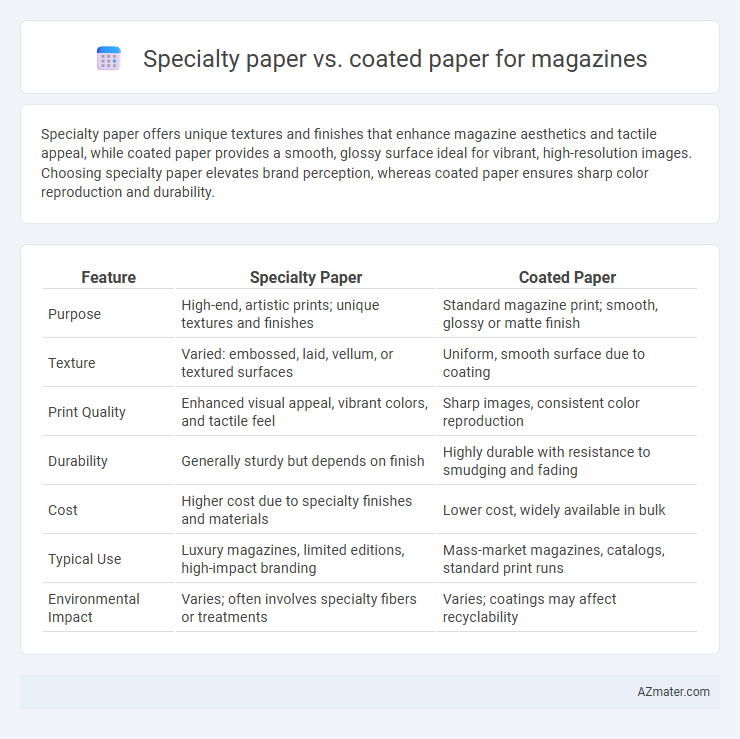Specialty paper offers unique textures and finishes that enhance magazine aesthetics and tactile appeal, while coated paper provides a smooth, glossy surface ideal for vibrant, high-resolution images. Choosing specialty paper elevates brand perception, whereas coated paper ensures sharp color reproduction and durability.
Table of Comparison
| Feature | Specialty Paper | Coated Paper |
|---|---|---|
| Purpose | High-end, artistic prints; unique textures and finishes | Standard magazine print; smooth, glossy or matte finish |
| Texture | Varied: embossed, laid, vellum, or textured surfaces | Uniform, smooth surface due to coating |
| Print Quality | Enhanced visual appeal, vibrant colors, and tactile feel | Sharp images, consistent color reproduction |
| Durability | Generally sturdy but depends on finish | Highly durable with resistance to smudging and fading |
| Cost | Higher cost due to specialty finishes and materials | Lower cost, widely available in bulk |
| Typical Use | Luxury magazines, limited editions, high-impact branding | Mass-market magazines, catalogs, standard print runs |
| Environmental Impact | Varies; often involves specialty fibers or treatments | Varies; coatings may affect recyclability |
Introduction to Specialty and Coated Papers
Specialty paper for magazines offers unique textures, finishes, and durability designed to enhance visual appeal and tactile experience, often featuring embossing, metallic, or soft-touch coatings. Coated paper, commonly used in magazines, provides a smooth, glossy, or matte finish that improves color vibrancy, sharpness, and print quality through a calcium carbonate or china clay surface layer. Choosing between specialty and coated paper depends on factors like desired aesthetic, print quality, and budget constraints in magazine production.
Defining Specialty Paper in Magazine Publishing
Specialty paper in magazine publishing refers to high-quality substrates designed to enhance visual appeal and tactile experience, including textured finishes, unique coatings, and varied weights tailored for specific editorial effects. Unlike standard coated paper, specialty paper offers distinctive properties such as UV resistance, matte or gloss alternatives, and eco-friendly options that improve print durability and color vibrancy. These attributes make specialty paper ideal for premium magazines aiming to differentiate their brand through superior print presentation and reader engagement.
Understanding Coated Paper: Types and Benefits
Coated paper, commonly used in magazine printing, comes in several types including gloss, matte, and satin, each offering distinct finishes that enhance image clarity and color vibrancy. This paper's smooth surface improves ink retention and reduces bleed, resulting in sharper text and more vivid visuals compared to specialty paper. Benefits of coated paper include improved durability, resistance to smudging, and a professional appearance that elevates magazine quality and reader engagement.
Visual and Tactile Differences
Specialty paper for magazines offers enhanced textures and finishes, such as embossed, metallic, or soft-touch coatings, providing a unique tactile experience that engages readers beyond visual appeal. Coated paper typically features a smooth, glossy, or matte surface achieved through application of clay or polymer layers, resulting in brighter colors, sharper images, and reduced ink absorption. The choice between specialty and coated paper significantly influences magazine aesthetics and reader interaction, with specialty paper emphasizing tactile distinction and coated paper prioritizing visual clarity and color vibrancy.
Print Quality: Color Vibrancy and Image Clarity
Specialty paper offers superior print quality for magazines, delivering enhanced color vibrancy and sharper image clarity due to its unique surface treatments and higher weight. Coated paper, while providing smooth finishes and adequate color reproduction, may lack the depth and richness seen in specialty paper varieties designed specifically for premium print results. Selecting specialty paper ensures more vivid hues and finer detail, elevating the overall visual impact of magazine content.
Durability and Handling Performance
Specialty paper offers enhanced durability with higher tear and water resistance, making it ideal for magazines requiring long-lasting quality and frequent handling. Coated paper provides a smooth surface that improves print vibrancy but tends to be more prone to fingerprints and creases, affecting handling performance over time. Magazines benefiting from robust handling and extended shelf life typically prefer specialty paper for its superior structural integrity.
Cost Comparison and Budget Considerations
Specialty paper for magazines typically incurs higher production costs due to its unique textures and finishes, often resulting in increased expenses compared to coated paper. Coated paper, favored for its smooth surface and cost-efficiency, provides a budget-friendly option without compromising print quality. Evaluating project scale and target audience helps determine if the premium investment in specialty paper aligns with marketing goals and financial constraints.
Sustainability and Environmental Impact
Specialty paper for magazines often incorporates recycled fibers and sustainable sourcing, reducing deforestation and lowering carbon footprints compared to traditional coated paper. Coated paper typically involves chemical treatments and plastic coatings, which can hinder recyclability and increase environmental impact through microplastic pollution. Selecting specialty paper enhances magazine sustainability by promoting biodegradability and supporting circular economy practices in print media production.
Best Applications for Specialty vs Coated Paper in Magazines
Specialty paper excels in high-end magazines requiring unique textures, finishes, or tactile experiences, making it ideal for luxury brands and art publications that emphasize visual impact and exclusivity. Coated paper is best suited for mass-market magazines demanding vibrant color reproduction and sharp image clarity, offering cost-effective production with smooth finishes like gloss or matte. Choosing specialty paper enhances premium branding, while coated paper ensures consistent quality and durability for everyday magazine circulation.
Choosing the Right Paper for Your Magazine’s Brand
Specialty paper offers unique textures and finishes that elevate a magazine's tactile appeal, reinforcing a distinctive brand identity and enhancing readers' sensory experience. Coated paper, available in gloss, matte, or silk finishes, provides vibrant color reproduction and sharp image quality, ideal for magazines emphasizing visual impact and clarity. Selecting the right paper hinges on aligning the magazine's brand personality with the desired aesthetic effect, whether aiming for luxury and exclusivity or crisp, colorful presentation.

Infographic: Specialty paper vs Coated paper for Magazine
 azmater.com
azmater.com